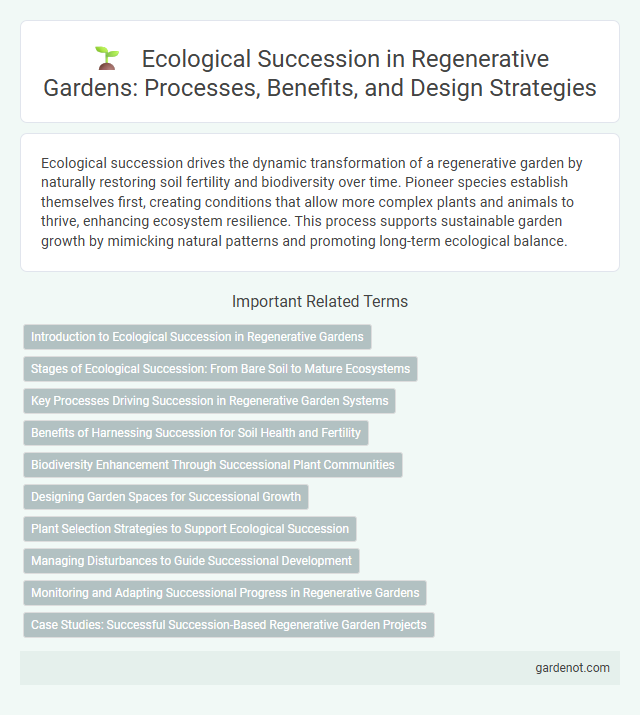Ecological succession drives the dynamic transformation of a regenerative garden by naturally restoring soil fertility and biodiversity over time. Pioneer species establish themselves first, creating conditions that allow more complex plants and animals to thrive, enhancing ecosystem resilience. This process supports sustainable garden growth by mimicking natural patterns and promoting long-term ecological balance.
Introduction to Ecological Succession in Regenerative Gardens
Ecological succession in regenerative gardens involves the natural progression of plant and animal communities that restore soil health and biodiversity over time. This process enhances ecosystem stability by promoting native species, improving nutrient cycling, and increasing habitat complexity. Understanding succession stages enables gardeners to design resilient landscapes that support long-term ecological balance and productivity.
Stages of Ecological Succession: From Bare Soil to Mature Ecosystems
Ecological succession in regenerative gardens begins with pioneer species colonizing bare soil, initiating soil formation and nutrient cycling. As succession progresses, intermediate species establish, increasing biodiversity and ecosystem complexity. Mature ecosystems develop diverse, stable plant and animal communities, supporting resilient and self-sustaining regenerative gardens.
Key Processes Driving Succession in Regenerative Garden Systems
Ecological succession in regenerative garden systems is driven by key processes such as soil nutrient cycling, plant community dynamics, and mutualistic interactions between organisms. Soil microorganisms decompose organic matter, releasing essential nutrients that enhance soil fertility and promote plant growth. Progressive changes in plant species composition improve habitat complexity, while symbiotic relationships with fungi and nitrogen-fixing bacteria facilitate ecosystem resilience and productivity.
Benefits of Harnessing Succession for Soil Health and Fertility
Harnessing ecological succession in regenerative gardens enhances soil health by promoting diverse plant species that naturally enrich soil structure and nutrient content. As pioneer plants establish, they improve organic matter and microbial activity, leading to increased fertility and water retention. This progressive succession reduces the need for synthetic fertilizers, fostering a sustainable and resilient garden ecosystem.
Biodiversity Enhancement Through Successional Plant Communities
Successional plant communities drive biodiversity enhancement by creating diverse habitats that support various species at different growth stages. Early successional plants improve soil quality and microclimates, enabling the establishment of mid- and late-successional flora, which together foster complex ecosystems. This dynamic process increases species richness and ecological resilience within regenerative gardens.
Designing Garden Spaces for Successional Growth
Designing garden spaces for successional growth leverages ecological succession principles to create dynamic, resilient landscapes that evolve naturally over time. By selecting pioneer species and arranging plant communities to mimic natural successional stages, gardeners enhance soil fertility, biodiversity, and habitat complexity. This approach ensures continuous regeneration and adaptability, supporting ecosystem functions and reducing maintenance needs.
Plant Selection Strategies to Support Ecological Succession
Selecting native pioneer species accelerates ecological succession by stabilizing soil and improving nutrient availability, fostering a conducive environment for secondary and climax species. Incorporating nitrogen-fixing plants enhances soil fertility, promoting a balanced microbial ecosystem essential for long-term garden sustainability. Strategic layering of plant communities mimics natural progression, encouraging biodiversity and resilience within regenerative garden systems.
Managing Disturbances to Guide Successional Development
Managing disturbances in regenerative gardens accelerates ecological succession by carefully shaping habitat conditions to favor desired plant communities. Techniques such as controlled burns, selective pruning, and soil amendment mimic natural processes, promoting biodiversity and resilience. These interventions guide successional stages toward stable, self-sustaining ecosystems with enhanced nutrient cycling and habitat complexity.
Monitoring and Adapting Successional Progress in Regenerative Gardens
Monitoring ecological succession in regenerative gardens involves regularly assessing soil health, plant diversity, and wildlife presence to gauge ecosystem development. Adapting successional progress requires implementing targeted interventions such as introducing pioneer species or modifying microhabitats to support desired vegetation stages. Continuous evaluation enables the optimization of biodiversity and resilience, ensuring long-term sustainability of the garden ecosystem.
Case Studies: Successful Succession-Based Regenerative Garden Projects
Case studies of regenerative garden projects demonstrate successful ecological succession by restoring soil health, increasing biodiversity, and establishing resilient plant communities. Projects such as the Beacon Food Forest in Seattle and the Greening the Desert initiative in Jordan illustrate how succession principles facilitate natural ecosystem development, enhancing carbon sequestration and water retention. These examples highlight the effectiveness of using pioneer species and native plants to accelerate habitat restoration and create sustainable food-producing landscapes.
Ecological succession Infographic

 gardenot.com
gardenot.com